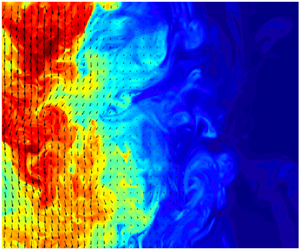Article contents
Entrainment and structure of negatively buoyant jets
Published online by Cambridge University Press: 25 January 2021
Abstract

Turbulent negatively buoyant jets occur when the buoyancy of a jet directly opposes its momentum, and will decelerate until its mean momentum is reduced to zero. Here, the flow reverses direction and, for an axisymmetric flow originating from a round inlet, returns annularly towards the source, mixing with the opposing fluid and forming a fountain. This investigation focuses on the initial stage of the flow, before the return flow is established. Data are obtained experimentally using two-dimensional particle image velocimetry and planar laser induced fluorescence for saline/freshwater negatively buoyant jets with source Froude number  $Fr_o=30$ and Reynolds numbers
$Fr_o=30$ and Reynolds numbers  $5500\lesssim Re_o\lesssim 5900$ at axial locations
$5500\lesssim Re_o\lesssim 5900$ at axial locations  $18\lesssim z/D\lesssim 30$, and compared to a neutral jet. The development of the mean and turbulence profiles with local
$18\lesssim z/D\lesssim 30$, and compared to a neutral jet. The development of the mean and turbulence profiles with local  $Fr$ are investigated, and it is found that, unlike neutral jets and plumes, the turbulence intensity in negatively buoyant jets does not scale with the mean flow. Additionally, the ratio of widths of the buoyancy and velocity profiles,
$Fr$ are investigated, and it is found that, unlike neutral jets and plumes, the turbulence intensity in negatively buoyant jets does not scale with the mean flow. Additionally, the ratio of widths of the buoyancy and velocity profiles,  $\lambda$, increases along the jet. The entrainment coefficient,
$\lambda$, increases along the jet. The entrainment coefficient,  $\alpha$, was estimated for a negatively buoyant jet, and was found to decrease with local
$\alpha$, was estimated for a negatively buoyant jet, and was found to decrease with local  $Fr$, eventually becoming negative, indicating fluid is being ejected from the jet. These observations differ to neutral or buoyant jets and plumes, which approach a constant
$Fr$, eventually becoming negative, indicating fluid is being ejected from the jet. These observations differ to neutral or buoyant jets and plumes, which approach a constant  $\lambda$ and
$\lambda$ and  $\alpha$ in the far field. This different behaviour in negatively buoyant jets is a natural consequence of the strongly decelerating mean flow as a result of opposing buoyancy, which is demonstrated in the context of the integral model framework developed by Morton et al. (Proc. R. Soc. Lond. A, vol. 234, no. 1196, 1956, pp. 1–23).
$\alpha$ in the far field. This different behaviour in negatively buoyant jets is a natural consequence of the strongly decelerating mean flow as a result of opposing buoyancy, which is demonstrated in the context of the integral model framework developed by Morton et al. (Proc. R. Soc. Lond. A, vol. 234, no. 1196, 1956, pp. 1–23).
JFM classification
- Type
- JFM Papers
- Information
- Copyright
- © The Author(s), 2021. Published by Cambridge University Press
References
REFERENCES
- 10
- Cited by





